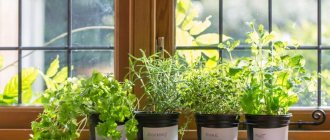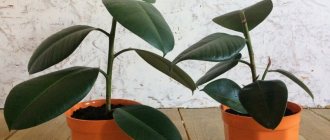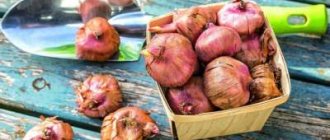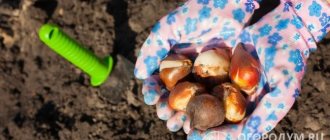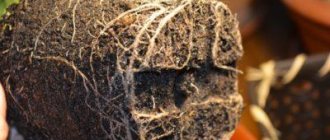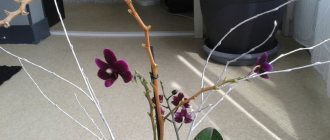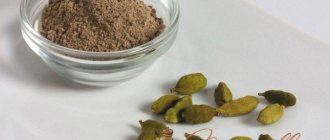Author of the article
Daria Vorontsova
Reading time: 10 minutes
AA
Exotic plants have long been grown at home. After all, they not only create comfort in the apartment, but also have useful properties. Cardamom is called the king of spices; this spice is one of the most expensive in the world. The plant belongs to the ginger family. Its leaves and fruits have a pronounced camphor aroma with notes of mint and citrus.
An evergreen bush can be grown at home on a windowsill, but you will have to put in a lot of effort. But the fragrant bush will please the eye, and you can count on a harvest.
The spicy-sweet spice is added to hot and sweet dishes, or to tea or coffee.
Cardamom varieties for growing on a windowsill
It is possible to grow a bush at home, but the appearance will be slightly different from its counterpart that grew in natural conditions. The most popular varieties of cardamom:
| Variety | Peculiarity |
| Green | The fruits ripen in green boxes, inside of which the grains are brown. One of the most common varieties. In cooking it is added to dough. |
| Black | The plant produces fruits in the form of black grains. Their aroma is similar to the smell of smoke, and they taste sharp. The plant is highly valued both as a spice and for its medicinal properties. |
| Ethiopian | This variety is an analogue of black cardamom. The fruits have a pronounced spicy aroma, but the spice is of lower quality. |
| White | Suitable for food use. The spice has a mild taste and lacks characteristic pungency. |
The most commonly used are black and green cardamom. The black variety has more than 179 subspecies, and the green variety has 11 varieties. Despite the fact that evergreen bushes do not grow in Russia, you can buy seed material at a flower shop.
Real cardamom and its legendary aroma
The plant, which all lovers of non-standard houseplants and medicinal potted plants know as true cardamom, actually belongs to the genus Elettaria. Amazing herbaceous perennials from the Ginger family (Zingibiraceae) are represented in nature by several dozen plants. But the only species considered as decorative is the same true cardamom , or cardamomum .
An evergreen perennial from among the medicinal and spicy plants, it is famous for the beauty of its stems and leaves. The rhizome of Elettaria cardamomum is fleshy. The height of indoor cardamoms is limited to 40-60 cm, but the plant does not seem miniature at all. Bushy, powerful, developing in the form of a turf from numerous vertical shoots, it truly resembles genuine bamboos with its silhouettes.
They look like stems, false shoots, stretching upward and covered with leaves, while real shoots remain almost invisible: leafless and creeping, they are hidden from prying eyes and are visible only up close. But it is the true second stem of the cardamom, and not the false shoots, that produces the flowers.
The leaves are in perfect harmony with the shoots - pointed, large, lanceolate-narrow. They are initially rolled into a tube and unfold interestingly, opening to their full length. Cardamom leaves sit alternately on fairly long graceful cuttings; they can reach a length of 60 cm with a maximum width of 8 cm. The rich dark green color is very attractive. But the main thing about leaves is not their beauty.
This is a unique indoor plant whose leaves are not only fragrant, but also healing. They can be used as an alternative to tea and brewed into drinks or herbal infusions. Subtle and surprisingly exotic undertones of cinnamon and cardamom scents are fascinating and invigorating. You can appreciate all the tart-spicy charm of cardamom only by rubbing the leaves between your fingers.
However, cardamom became famous for the aroma not of the leaves, but of the fruit. The flowering of a plant is an extremely unusual sight. Elettaria cardamomum flowers appear on creeping true shoots and are collected in clusters. They would be inconspicuous if not for one prominent petal of a snow-white color with bright purple veins, which contrasts so strikingly with the light green and small other petals.
After flowering, at the site of the cardamom ovary, original three-lobed fruit capsules up to 2 cm long develop, hiding those very richly aromatic, ribbed black seeds that have become one of the most popular spices in the world. The flowering of cardamom cannot be called spectacular, but due to the unusual arrangement of the flowers - under the main aerial parts at the base of the turf of false shoots - and unusual fruits, it is more than original.
True cardamom, or Elettaria cardamomum. © Michelle
What you need to grow cardamom
Growing exotic plants at home is painstaking work. After all, in natural conditions they are accustomed to a warm climate and high humidity. In any case, before planting cardamom at home, you need to buy the necessary ingredients.
- Seeds, roots, or cuttings of perennials;
- Spacious container;
- Nutrient substrate;
- Drainage filler;
- Fertilizers for indoor flowers.
Once all the equipment is prepared, you can begin planting. A little patience and love in the process will not be superfluous.
Choosing the optimal place in the house
Room temperature is favorable throughout the life cycle of cardamom. The plant loves warmth and diffused sunlight, so the optimal place in the house is a windowsill. A glazed balcony or loggia is also good. Glass protects the leaves from direct sunlight. In summer, the plant is taken out into the fresh air for several hours a day.
In winter, cardamom is dormant and its growth slows down. However, you should not place pots with bushes in partial shade. The plant will be comfortable on a windowsill on the south side without drafts. When choosing the optimal location in the house, you should choose well-lit areas near windows. The fragrant bushes grow up to a meter in height with long leaves, so it is important to provide the plant with space.
You should not place containers with cardamom near heating appliances. The hot air causes the leaves to dry out and the soil to dry out.
Selection and preparation of containers
You can grow cardamom at home in a spacious container. The roots of this small tree are massive and strong, so the container should be low but wide. These can be either clay pots or ceramic flowerpots.
- Since the plant loves watering, wooden containers should not be chosen due to low moisture resistance.
Before planting, pots or flowerpots are thoroughly washed with running water. Remains of old soil or debris are washed away. If the container is new, then it should not have a specific smell. Then wide holes are made at the bottom to allow water to drain. Pallets are placed under the pots.
Soil selection
A high-quality fertile substrate is 50% of success when growing a cardamom plant at home. The miniature tree prefers loose soil with good moisture and air permeability. Ready-made soil can be bought at a flower shop. A universal substrate or a special one for ornamental plants is suitable.
Do not compact the soil in the pot too much: it should be loose and well-permeable to oxygen.
It is possible to prepare the soil on your own from a mixture of turf soil, humus and sand (2:2:1). Soil rich in humus is also suitable for cardamom. Ideal pH: 5-6. The bottom layer is covered with drainage filler.
Creating the necessary conditions: lighting, air humidity, temperature
Cardamom is demanding on lighting. He loves bright but diffused light. In nature, the evergreen perennial grows under the canopy of trees that diffuse direct sunlight. Despite the fact that the plant is in a state of hibernation in winter, the light intensity cannot be reduced. As additional light, phytolamps are installed at a safe distance from the bush.
The tropical tree responds positively to water treatments in the shower, spraying with warm water and wiping the foliage with a damp sponge. The room where the spice grows is ventilated at least once a day. Like any exotic plant, cardamom loves warmth. Favorable temperature in the room in summer is +20-25°C. In winter, lowering the temperature to +13-15°C does not harm the growth of the tree.
Should you grow exotic plants at home?
Of course not
Conditions for cardamom germination
So, what should be taken into account for the emergence of seedlings:
- the soil should be rich in humus, slightly acidic, with a pH of 5.5 to 6.0;
- air temperature is required within 25-28 degrees;
- humidity – high: just cover with film and provide abundant watering;
- the illumination is moderate: the box with the sown seeds should be placed in a shaded place without drafts.
What do we get? Tropical forests are humid and have little sunlight shining through the abundant vegetation. Quite hot, rather stuffy. But again, tropical thickets prevent the heating of the lower layer - the habitat of wild cardamom. We are trying to create approximately these conditions.
Growing from seeds
The main feature of growing cardamom on a windowsill from seeds is the freshness of the seed. Fragrant grains quickly lose their viability, so freshly harvested seeds are planted in containers with peat and sand at a temperature of +25°C. There is no need to soak or germinate the seeds before planting.
Preparing seeds for planting:
- Fresh grains are placed in a weak solution of potassium permanganate. The procedure is optional and is used for disinfection purposes;
- Drainage is laid out at the bottom of the pot, soil is poured on top;
- Plant 2 seeds in one container to a depth of at least two centimeters;
- Sprinkle with a thin layer of earth, cover with film or a glass jar;
- In greenhouse conditions, the grains are moistened and periodically ventilated.
The first shoots appear after 1-2 months.
After the first shoots, the sprouts do not need additional shelter. It is enough to provide humidity and warmth.
Features of a “house” plant
Eletaria cardamomum, grown at home, has a height of up to 90 cm, grows at approximately the same speed in height and width, so it needs enough space.
For active growth, the flowerpot must be placed under sunlight, but not direct, but diffused. Contact with the sun is required all year round. Optimally - on a windowsill in a room that opens onto a glazed balcony or loggia: protection in the form of two windows will help protect the plant from scorching rays. In nature, cardamom also grows better in sunny areas, but when shaded, for example, by a tree with a wide crown. This is a heat-loving plant, so you need to try to organize a temperature for it of 23-25°C in summer and not lower than 12°C in winter. It also loves moisture, so regular spraying should be made a rule.
Planting and propagation
In order for a houseplant to take root, it must be grown in suitable soil. You can buy one ready for deciduous plants with a pH level in the range of 5.5-6, or mix it yourself from the following composition:
- turf soil - 2 parts;
- humus - 2 parts;
- river sand - 1 part.
It is necessary to lay a drainage layer - this will allow moisture not to linger, which is a prevention of root rot.
Cardamom propagates in three ways:
- Grown from grains.
- Method of rooting the tops.
- Root division.
In the first case, after laying the drainage and a layer of soil, put two grains in a flowerpot (only freshly harvested seeds are suitable, otherwise they will not germinate), sprinkle a small layer of soil on top, water and cover with film (or a glass jar). The place where the flowerpot stands should be well lit and at the temperature specified above. It is necessary to ventilate the greenhouse daily to prevent the development of mold. The seedlings will grow in 30-50 days, but they need to be kept in greenhouse conditions until the plant height reaches 15-20 cm. Only after this can the cardamom be planted in shallow, wide flowerpots.
When propagating by rooting the tips, a cutting 5-10 cm high is cut from an already mature plant, and the cut site is sprinkled with crushed activated carbon. The cuttings are treated with a means to accelerate root growth and placed in a container with water or wet sand. As soon as the roots appear, the plant is transplanted into a flowerpot and watered. It is important not to forget to spray the flower regularly.
When propagated by roots, the rhizome is divided into two parts, the cut site is sprinkled with crushed activated carbon (to prevent rotting) and immediately planted in flowerpots with fresh soil. The soil must be freshly prepared, since old soil has a significantly lower content of useful microelements necessary for active plant growth. Actually, that’s why any indoor flower needs to be replanted 1-2 times a year.
Plant care
The plant needs constant watering. In summer this should be daily, in winter - during the rest period - once every 10-14 days.
It is worth feeding cardamom for intensive growth only in the spring-summer period and not earlier than two months after transplantation - until this time the flower takes everything it needs from the soil. For this purpose, organo-mineral fertilizers for vegetable crops are used. It is important not to frequently use fertilizers containing nitrogen - this can harm the plant! In winter, you can use “Zircon” or “Ferovit” once every 2 weeks to increase resistance to dry air.
Growing flowers at home means not only ensuring their growth, but also forming a beautiful crown. This will not happen without pruning. It is held annually in March-April. Basic rules for cutting cardamom:
- in order for the “false” trunk to stretch upward, the second one - the side one - must be completely removed;
- if you trim the shoot, but leaving 2-3 buds, the plant will begin to form a bush;
- all branches that violate the aesthetics can be safely trimmed;
- branches that are directed at each other and interfere with themselves should also be thinned out;
- The shoots of an elongated trunk will be uniform if you pinch the top.
By the way, its leaves contain essential oils, so they can be used as natural air fresheners - just pick a few leaves and bend them in half, making creases so that the essential oil flows out.
Growing cardamom at home is quite possible. Cardamom is a truly beautiful plant that will create coziness in your home for many years.
Growing by dividing rhizomes
Propagating cardamom by dividing the roots is the fastest and easiest way. However, for this you will have to wait until the plant gets stronger. This usually takes 6-12 months from the first shoots. The rhizome is carefully cut with a knife so that each part has at least a pair of buds and growing roots. The separated roots with shoots are planted in moist nutrient soil, after which care is provided.
Contraindications
Every product has contraindications. Taking cardamom can cause harm to people:
- with individual intolerance;
- pregnant women. Of course, you cannot completely exclude spices, but taking them in limited quantities will not harm the health of the baby and the mother;
- breastfeeding;
- prone to allergies;
- with gallbladder disease;
- with high acidity;
- with disease of the gastric mucosa;
- with gastritis;
- peptic ulcer disease.
Everything requires moderation, even a healthy person can get diarrhea. In the future, this threatens dehydration of the body. You can add a quarter of a teaspoon of powder once for an adult.
The spice should enhance the prepared dish with its delicate aroma, and not overwhelm it. It is not advisable for young children under 2 years to eat dishes with spices. When using cardamom oil, you should also follow the dosage as it is considered toxic.
Growing by cuttings
Cuttings can only be taken from an adult plant. Ideal length of shoots: 7-10 cm. To do this, cut off the apical shoots of cardamom and place them in a jar of water or wet sand. In order for the cuttings to take root faster, the cutting sites are treated with a growth accelerator solution.
After the roots appear, the standard procedure for planting the plant in a pot follows.
Cuts on the rhizomes are treated with crushed activated carbon so that they do not rot.
What are the beneficial properties of cardamom?
The plant is rich in B vitamins, ascorbic acid, and rutin. It contains trace elements, minerals, proteins, thiamine. It improves body tone and prevents illness. I drink a drink with cardamom for prevention:
- flu;
- colds;
- cough;
- diabetes
For me, growing rosemary and elettaria in my apartment is a way not only to create an aesthetic corner, but also a source of healthy products.
I use cardamom oil as an antiseptic to help with sore throats and fungal infections. For pulmonary diseases, it helps improve expectoration.
Water procedures with cardamom oil help to calm down. By adding it to food I eliminate heartburn.
Plant care: watering, fertilizing and pruning
Since cardamom comes from warm countries, it loves abundant watering. However, excess moisture at the roots is more critical for the plant than drying out the earthen clod. Water the tropical tree abundantly, avoiding stagnation of water. In summer, watering is needed every day. In winter, it will be enough to moisten the soil once every one and a half to two weeks.
As for feeding, during the period of active growth of seedlings, the soil is fertilized for the first time after 2 months. This is due to the fact that the sprouts absorb maximum nutrients from the soil. Then fertilizing is applied only to stimulate growth in spring and summer. Fertilizers with a mineral-organic composition are ideal.
Cardamom usually blooms in the third year. The flowers are elongated, from soft pink to purple. The tree will not be able to form a lush crown without pruning. The procedure is carried out during the active growth stage in the spring.
How to prune a plant correctly:
- Dense branches that interfere with normal growth of each other are removed;
- The side trunks are cut off so that the main false one actively grows upward;
- A new bush will form if at least a couple of buds remain on the cut shoot.
Cardamom leaves are natural air fresheners.
To ensure that the shoots grow evenly and the crown is lush, the green tops are pinched.
Cardamom in nature
In our latitudes, and even more so in the “greenhouse” version, this is not so easy to do. This plant does not grow in Russia. The historical homeland of cardamom is India. Where cardamom grows today is a long list: its natural habitat is India, Sri Lanka, the southern provinces of China, Guatemala and other humid tropical and subtropical regions. The plant is accustomed to the sun and high humidity. But you can also grow it at home if you wish. True, the appearance will be somewhat different - the leaves will be narrower and elongated compared to analogues growing on plantations. This always happens when there is a lack of ultraviolet radiation - no artificial lighting can completely replace the sun's rays.
The cardamom plant itself, or Elettaria cardamomum, is perennial and evergreen. In nature, it blooms already in the first year of life, in conditions of home cultivation - if it blooms, then in the third year. Eletaria cardomum has two types of stems: one is false, directed upward and strewn with dark green leaves up to 60 cm in length and up to 8 cm in width; the second is real, has a horizontal orientation, has no foliage, but is strewn with flowers. Cardamom blooms in small inflorescences, and on each bud one petal is white with a purple tone, the rest are pale green. After flowering, triangular seed boxes with aromatic grains inside remain.
Diseases and pests
Cardamom is susceptible to viral infections among representatives of the flora. In addition, excess humidity can provoke fungal diseases.
Shchitovka
Spider mite
The main pests are scale insects and spider mites. You can destroy the scale insect by treating the leaves with a soap solution. Then the concentrate is washed off so that the solution does not get into the roots. Fight spider mites with insecticides. The preparations “Fitoverm” and “Aktofit” are used in several stages, since they do not act on parasite eggs.
Aktofit
Fitoverm
The main reason for the appearance of pests at home is lack of moisture and dry air. Insects are not repelled by the essential oils contained in the leaves. Small parasites settle on shoots and the inside of leaves and suck the juice out of the plant.
Is it difficult to care for cardamom in the room?
Not really
What does a cardamom plant look like?
Eletaria has two types of stems: its true stem is creeping, without leaves. Clusters of flowers bloom on it, one petal is white with a purple pattern, the rest are greenish. In place of the flowers, fruits will then appear - triangular boxes with seeds inside; These are the grains of paradise - the spice cardamom. The other stem, false, is covered with leaves. The leaves of eletarium are linear-lanceolate, on thin petioles, 60 cm long and up to 8 cm wide, entire, green, shiny. If you rub a piece of leaf between your fingers, you will feel a tart aroma. The green cardamom plant has an excellent decorative appearance; at home it reaches a height of 90 cm.
What other spices can you grow at home:
How to grow ginger at home
Usage
According to specialists, cardamom is the third heaviest spice after saffron and vanilla. Cardamom seeds, whole or ground, are often used in Indian and Asian cuisines. Trade and consumption have a long history, with fruits being traded in India for over 1000 years. In the early 1900s, German coffee planter Oscar Majus Kloffer introduced cardamom to Guatemala. Until about 1980, India was the largest producer and exporter of cardamom, until Guatemala became No. 1.
Although cardamom is used throughout the world, some of its main consumers are in the Middle East, where the spice is often added to tea and coffee, and Scandinavian countries, where it is often added as a flavoring to baked goods. As the main ingredient in curry powder, cardamom can be used to flavor rice, meat, vegetables, liquors and ice cream. Guatemala and Mexico now use it to flavor chewing gum. It is also used to treat stomach/urinary tract problems, asthma, bronchitis, heart problems, indigestion, nausea, sore throat, depression, skin conditions and bad breath. Besides culinary and medicinal uses, cardamom can also be included in cosmetics and perfumes.
Features of flower pruning
The basic rules for pruning plants include:
Interesting facts about cardamom
It is the varieties of green and black cardamom that are most popular, as their seeds have a pronounced aroma and medicinal properties.
Even in Ancient Greece, this plant was called “grain of paradise”, due to the fact that the seed material was actively used not only in cooking, but also in medicine and aromatherapy. And it is still believed that all the properties of cardamom have not been fully disclosed. And in the ancient Indian epic there are references to the “queen of spices” a thousand years BC. And already in the 1st century AD, the Greek philosopher Plutarch wrote that cardamom was used in ceremonies in temple complexes or mixed into perfumes in Ancient Egypt. Europe became acquainted with this spice thanks to the Arabs, who brought it to these territories, but in those days cardamom was used mainly only for making perfumes. Pedanius Dioscorides (about 40 AD to 90), who was a famous ancient Greek pharmacologist, physician and naturalist, preferred the seeds of the cardamom that came from Armenia, but Ovid did not stay away from praising the aroma of this wonderful spice.
It is best to buy cardamom in pods, since if you buy an already ground product, its aroma evaporates very quickly. Be sure to remove the seeds from the pods before grinding - this will allow the aroma to be more intense.
Eastern healers have long known that cardamom helps remove mucus from the body and is used in the treatment of bronchitis, cough, colds or asthma. There is evidence that cardamom can be used to cleanse the gastrointestinal tract, and if the “queen of spices” is included in medicinal preparations, it will increase appetite and improve digestion. Cardamom also helps cleanse the mouth and breath, neutralizing pathogenic flora.

